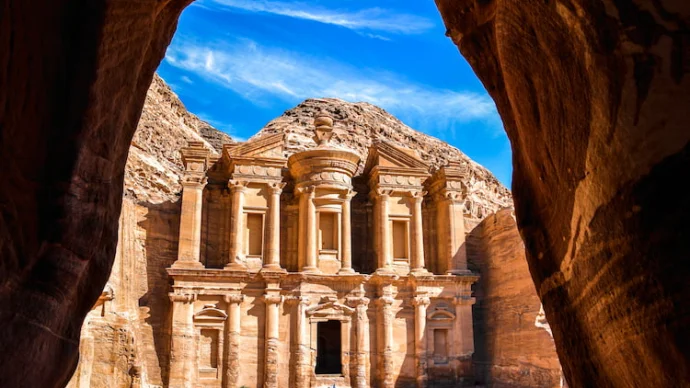
About Petra
Petra is an iconic ancient site in southern Jordan. A secret to all but the Bedouins until 1812, Petra’s incredible monuments are now considered to be one of the wonders of the world.
History of Petra
Petra was established by the once nomadic Kingdom of the Nabataeans. Carving a city out of the sandstone rocks and cliffs, the Nabataeans settled and made Petra into their capital. The Nabataeans chose this site carefully, selecting a place which was located along the paths of numerous strategic caravan trails.
It is unknown when Petra was first founded, but it was inhabited from prehistoric times and fully established by the fourth century BC, by which time it had achieved fame as an incredible feat of architecture. In 312 BC, Petra was attacked in by Antigonus I Monophthalmos, who had once been a general of Alexander the Great, although he failed to capture it.
Petra continued to thrive under the Nabataeans, growing into a centre of trade with around 300,000 citizens and becoming extremely prosperous. It managed to resist numerous invasions and conquests, including by the Hasmonean Jewish Commonwealth and by the Romans. However, in 106 AD, during the reign of the Roman emperor Trajan, Petra lost its independence as it was absorbed into the Roman Arabian territory.
Petra maintained its status as an important trading centre throughout its time under the Roman Empire. It was only as the empire fell and following a series of earthquakes that Petra declined, at one point being a Crusader stronghold, but eventually forgotten.
Petra today
Today, visitors to Petra cannot help but be inspired by its incredible remains. Intricate temples and tombs emerge from rocks and cliffs together with later additions from the Roman era and even a Byzantine church resplendent with mosaics. Other Roman remains include the tomb of the Roman governor Sextius Florentinus, the remains of a Roman palace and the remains of the main colonnaded road.
However, it is Petra’s most impressive and well-preserved monument, The Treasury, which is the first site to greet most visitors. Comprised of an elaborate façade hewn into the rock, The Treasury is thought to date back to the first century BC although its actual purpose is unknown (it may have been a temple, perhaps a tomb).
If the façade of Petra’s Treasury looks familiar, this might be because of its prominent appearance in the film ’Indiana Jones and the Last Crusade’. Sadly, the inside of this monument does not meet the expectations created by its exterior – it is in fact remarkably bare.
There are several other sites to see along the way including Petra’s theatre and an array of rock-carved tombs. Petra is now a UNESCO World Heritage site and is well served by the Jordanian tourist industry.
It’s worth getting at least a 2 day pass as there’s so much to see. Note that the site opens at 6am: the earlier you go, the less hot it will be and the more chance you have of catching some of the magical early morning light and calm.
Getting to Petra
Petra is located in the Jordanian desert: it’s roughly a 3 hour drive from Amman. A bus runs once daily from the 7th Circle JETT bus station in Amman to Petra, and there’s also a bus from Aqaba. Look out for signs to Wadi Musa, the nearest village, which is where you’ll probably end up staying and eating.
Featured In

Top UNESCO World Heritage Sites
UNESCO protects over 1,000 Heritage Sites around the world. But which ones are the must-sees? From the Pyramids of Egypt to the Taj Mahal, here are 10 spectacular UNESCO locations that are well worth a visit.

Jordan Historic Sites
Jordan is a young state on an ancient piece of land which bears the marks of many different cultures, religions, and political systems through its wealth of fascinating sites. Here's our selection of 10 sites which you shouldn't miss when visiting.



















